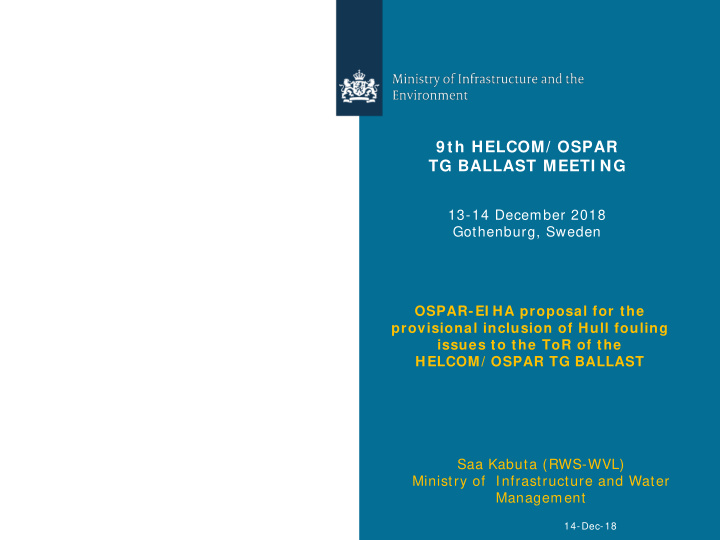



9 th HELCOM/ OSPAR TG BALLAST MEETI NG 13-14 December 2018 Gothenburg, Sweden OSPAR-EI HA proposal for the provisional inclusion of Hull fouling issues to the ToR of the HELCOM/ OSPAR TG BALLAST Saa Kabuta (RWS-WVL) Ministry of Infrastructure and Water Management 14-Dec-18
Background In 2011 the IMO adopted resolution MEPC.207(62), as the ‘Guidelines for the control and management of ships' biofouling to minimize the transfer of invasive aquatic species’ In 2012, the MEPC approved the Guidance for minimizing the transfer of invasive aquatic species as biofouling (hull fouling) for recreational craft (see MEPC 64/ 23, para 11.8). In 2013, the MEPC approved the Guidance (MEPC.1/ Circ.811) for evaluating the Guidelines for the control and management of ships' biofouling to minimize the transfer of invasive aquatic species (MEPC.207(62). During the preparation of the evaluation guidance, Australia, the Netherlands and New Zealand proposed a new output (MEPC 72/ 15/ 1) to the biennial agenda of MEPC for reviewing the IMO guidelines (MEPC.207(62) for both commercial and recreational ships. In 2016, OSPAR-Environmental Impact of Human Activities (EIHA) received highlights from the Netherlands regarding biofouling as an important pathway for non-native species and promised to commission a study to investigate the significance. I n 2 0 1 8 , OSPAR-EI HA, received additional inform ation on biofouling indicating the significance of its effect as a pathw ay for m arine non native species across the w orld, and the scarce know ledge about the I MO guidelines in the relevant sectors. 2 14-Dec-18
Research Areas 2 0 1 7 Gittenberger, A., Wesdorp, K.H. & M. Rensing , 2017. Biofouling as a transport vector of non-native marine species in the Dutch Delta, along the North Sea coast and in the Wadden Sea. Overview of locations Overview of harbours in investigated (2010-2016.) the Netherlands 3 14-Dec-18
Distribution patterns of non native species A] Primary distribution patterns [B] Secondary distribution patterns throughout NW Europe. 4 14-Dec-18
Fouling of pleasure crafts of different lengths 5 – 10 meters, 10 – 15 meters 15 meters. . 5 14-Dec-18
Fouling status of different boat types Sailing boats (n=1208) and Motorboats (n=755) . 6 14-Dec-18
Activities in 2 0 1 8 OSPAR 2 0 1 8 OSPAR-EIHA meeting agreed to provisionally add the issue of hull fouling to the terms of reference of the HELCOM/ OSPAR Joint Task Group on Ballast Water, subject to agreement by HELCOM Maritime and to ask the Netherlands to present a document on this issue at the next JTG- Ballast meeting, if the change to the ToR was agreed HELCOM 2 0 1 8 HELCOM Maritime meeting discussed the proposed amendment to the JTG-HELCOM/ OSPAR ToR to include hull fouling of recreational vessels. While some members supported the proposal, concern was also raised due to the limited timeline (2017-2020) and scope of the current ToR, and the possible need to enhance the ToR more than just including biofouling of recreational vessels. HELCOM Maritime 2018 agreed that the matter should be considered further at TG Ballast before the matter could be submitted to HELCOM HOD for approval. The Netherlands 2 0 1 8 The Netherlands commissioned a study to highlight the challenges and the opportunities for the implementation of Biofouling Guidelines for recreational boats. This study was based upon questionnaire presented in the IMO evaluation guidance document (MEPC 1/ Circ.811) and 6 additional questions previously possed by the Netherlands to OSPAR-EIHA 2018 7 14-Dec-18
Next steps and the input of HELCOM/ OSPAR TG To take the investigation forward to regional seas levels and even beyond, OSPAR-EIHA perceives the input from the Joint HELCOM/ OSPAR Task Group to be inevitable with regards to : -the Coordination of the evaluation of the IMO Biofouling Guidelines (MEPC.207(62) and (MEPC.1/ Circ.792) ) using the evaluation guidance (MEPC.1/ Circ.811) as the basis document The Joint HELCOM/ OSPAR Task Group has the relevant structural composition and expertise to harmonise the development of methods that could be used for the desired investigation in the member states The results of the investigations: -used as contribution to the existing review process of the guidelines at IMO, -used to inform OSPAR- EIHA 2019, OSPAR 2019 and HELCOM 2019 for future activities towards the implementation of the IMO biofouling Guidelines in the respective regional seas. 8 14-Dec-18
Actions Requested (1) To take note of the information provided TO SUPPORT hull fouling of recreational boats as an important pathway for non-native species as shown in the Dutch Delta area of the North Sea coast and Wadden Sea; (2) To discuss the occurrence and relevance of hull-fouling as pathway for NIS and concerns regarding awareness and application of IMO guidance on this issue among recreational boat-owners and harbour masters in the HELCOM and OSPAR convention areas; (3) To discuss the harmonisation process of the proposed IMO evaluation procedure for the Biofouling Guidelines (MEPC.207(62) Commercial ships) and the guidance ( MEPC.1/Circ.792, R ecreational boats) with a view to contribute to the work done at IMO using the evaluation guidance (MEPC.1/ Circ.811) as the basis. (4) Consider the information in the documents and the discussions at this meeting to describe the next steps such as taking up the issue of hull fouling (recreational and commercial crafts) in the current ToR for JTG Ballast or by means of setting up a new Joint Task Group for Bio-fouling. 9 14-Dec-18
Acknow ledgem ent Erfeling, Mareike, (RWS-ZD), Ministry of Infrastructure and Water Management, mailto: mareike.erfeling@rws.nl Sander Smoledrs –NVWA, Ministry of Agriculture, and Food security, a.a.j.smolders@nvwa.nl; Drs.Lyklema, N.R. (Niels) - DGB , Ministry of Infrastructure and Water Management, niels.lyklema@minienm.nl 10 14-Dec-18
THE END THANK YOU 11 14-Dec-18
12 14-Dec-18
13 14-Dec-18
14 14-Dec-18
THE END 15 14-Dec-18
Recommend
More recommend